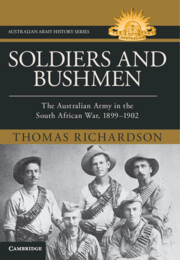Refine search
Actions for selected content:
43 results
Chapter 6 - Counterinsurgency
-
- Book:
- Soldiers and Bushmen
- Published online:
- 29 July 2025
- Print publication:
- 06 August 2025, pp 147-172
-
- Chapter
- Export citation
Chapter 8 - Conclusion
-
- Book:
- Soldiers and Bushmen
- Published online:
- 29 July 2025
- Print publication:
- 06 August 2025, pp 198-201
-
- Chapter
- Export citation
Chapter 5 - Combat
-
- Book:
- Soldiers and Bushmen
- Published online:
- 29 July 2025
- Print publication:
- 06 August 2025, pp 120-146
-
- Chapter
- Export citation
Chapter 2 - The Australian Army in South Africa
-
- Book:
- Soldiers and Bushmen
- Published online:
- 29 July 2025
- Print publication:
- 06 August 2025, pp 35-71
-
- Chapter
- Export citation
Chapter 1 - Raising Australia’s Army
-
- Book:
- Soldiers and Bushmen
- Published online:
- 29 July 2025
- Print publication:
- 06 August 2025, pp 10-34
-
- Chapter
- Export citation
Chapter 3 - Command
-
- Book:
- Soldiers and Bushmen
- Published online:
- 29 July 2025
- Print publication:
- 06 August 2025, pp 72-96
-
- Chapter
- Export citation
Introduction
-
- Book:
- Soldiers and Bushmen
- Published online:
- 29 July 2025
- Print publication:
- 06 August 2025, pp 1-9
-
- Chapter
- Export citation
Chapter 4 - Morale
-
- Book:
- Soldiers and Bushmen
- Published online:
- 29 July 2025
- Print publication:
- 06 August 2025, pp 97-119
-
- Chapter
- Export citation
Chapter 7 - Coercion
-
- Book:
- Soldiers and Bushmen
- Published online:
- 29 July 2025
- Print publication:
- 06 August 2025, pp 173-197
-
- Chapter
- Export citation

Soldiers and Bushmen
- The Australian Army in South Africa, 1899–1902
-
- Published online:
- 29 July 2025
- Print publication:
- 06 August 2025
Chapter 3 - Preserving scratch
- from Part 2 - Mobilising resources for war
-
-
- Book:
- Mobilising the Australian Army
- Published online:
- 23 May 2025
- Print publication:
- 30 May 2025, pp 50-70
-
- Chapter
- Export citation
Chapter 4 - Industrial mobilisation
- from Part 2 - Mobilising resources for war
-
-
- Book:
- Mobilising the Australian Army
- Published online:
- 23 May 2025
- Print publication:
- 30 May 2025, pp 71-93
-
- Chapter
- Export citation
Introduction
-
-
- Book:
- Mobilising the Australian Army
- Published online:
- 23 May 2025
- Print publication:
- 30 May 2025, pp 1-10
-
- Chapter
- Export citation
Chapter 15 - The Kangaroo Exercise Series, 1989–1995
- from Part 6 - Deployment challenges
-
-
- Book:
- Mobilising the Australian Army
- Published online:
- 23 May 2025
- Print publication:
- 30 May 2025, pp 320-343
-
- Chapter
- Export citation
Chapter 8 - Concurrency pressures of accelerated warfare
- from Part 4 - Alliance and concurrency pressures
-
-
- Book:
- Mobilising the Australian Army
- Published online:
- 23 May 2025
- Print publication:
- 30 May 2025, pp 170-176
-
- Chapter
- Export citation
Chapter 1 - The Australian Army, mobilisation and its recent intellectual history
- from Part 1 - Mobilising an army
-
-
- Book:
- Mobilising the Australian Army
- Published online:
- 23 May 2025
- Print publication:
- 30 May 2025, pp 12-28
-
- Chapter
- Export citation
Chapter 14 - Reserve mobilisation for domestic contingencies
- from Part 5 - Force preparation
-
-
- Book:
- Mobilising the Australian Army
- Published online:
- 23 May 2025
- Print publication:
- 30 May 2025, pp 297-318
-
- Chapter
- Export citation
Chapter 18 - Where to from here?
- from Part 7 - Reflections
-
-
- Book:
- Mobilising the Australian Army
- Published online:
- 23 May 2025
- Print publication:
- 30 May 2025, pp 388-400
-
- Chapter
- Export citation
Chapter 5 - A double-edged sword
- from Part 2 - Mobilising resources for war
-
-
- Book:
- Mobilising the Australian Army
- Published online:
- 23 May 2025
- Print publication:
- 30 May 2025, pp 94-122
-
- Chapter
- Export citation
Chapter 10 - The Australian Army’s growing concurrency pressures, 2003–2010
- from Part 4 - Alliance and concurrency pressures
-
-
- Book:
- Mobilising the Australian Army
- Published online:
- 23 May 2025
- Print publication:
- 30 May 2025, pp 201-224
-
- Chapter
- Export citation
